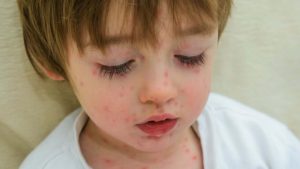What You Need to Know about Scarlet Fever

When children are suffering from scarlet fever, they don’t always get proper treatment. As a result, they may take longer to recover and get over the symptoms.
That’s why it’s important to find out everything you can about how to properly care for this illness.
Whether someone close to you has suffered from scarlet fever or you’ve experienced it yourself, certain aspects of this illness are often overlooked, especially regarding the care needed.
In general, treatment for scarlet fever usually consists of a series of measures that may seem quite simple, but are of vital importance.
They not only allow for the individual’s health to improve, but they also eliminate the possibility of any long-term damage or major complications.
What do you remember about scarlet fever
Scarlet fever is a childhood disease that is caused by the bacteria group A Streptococcus. This bacteria is part of a family of germs that originate in the tonsils.
Group A Streptococcus often produces a toxin that creates a widespread skin eruption the color of crimson (hence the disease’s name).
It’s important to clarify that not all strep infections produce this substance, and not all children are sensitive to it.
For example, two siblings living in the same home can both contract this bacteria, but the illness may take a different course in each child. One child may be sensitive to the toxin whereas the other may not.
Children who suffer from this rash must receive special topical medications to treat the condition.
But how is the disease transmitted? Basically, it occurs through direct contact with the saliva of infected children. The saliva can be transmitted while talking, coughing or sneezing.
It’s also possible for the germ to spread through the sharing of utensils or toys that children have put in their mouths. Therefore, isolation is very important when dealing with scarlet fever.
The evolution of scarlet fever
The effects of infection come on very suddenly. The glands in the bottom of the neck swell up, which is very painful.
In addition, the following symptoms are also related to scarlet fever:
- Trembling
- Vomiting
- Lack of appetite
- Headache
- Sore throat
- Swollen tonsils
- Apathy or general lack of interest (meaning your child probably doesn’t even want to play).
During the next 12 to 48 hours, a skin rash will appear around the groin area, the armpits and the neck. Later this rash will spread to the rest of the body. The red spots can be seen all over the skin and are slightly raised.
At the same time, the tongue will become covered in a layer of white. The taste buds will swell and become redder than usual. Later, the child’s skin will become scaly.
On the sixth or eighth day, the pain intensity will decrease. If fever flares up again at this point, it could be a sign of some complication that should be treated immediately.
After the ninth day, the child’s skin begins to peel, starting with the face and abdomen and then finally spreading down to the hands and feet.
What you should know
Unfortunately, scarlet fever can come back several times during childhood because it is brought on by several streptococci from different strains. This means that vaccination is not as effective as with other illnesses.
Scarlet fever doesn’t involve any complications as long as the necessary medications are administered. If not, it may bring on consequences such as rheumatic fever, which causes inflammation of the heart, joints and blood vessels.
If left untreated, scarlet fever can also lead to glomerulonephritis, which affects renal functions in little time.
Vaccination is not effective in preventing scarlet fever
Whether the skin rash is present or not, consulting with a doctor is absolutely necessary.
A medical specialist will determine what course of treatment is appropriate for the patient. It’s very important to be aware of the composition of the medication prescribed, as well as the dosage and the short, medium and long-term effects.

How to care for a child with scarlet fever
- Rest is fundamental. Even when your child is well enough to go back to school, rest is still important. It’s always good for your child to feel comfortable and well attended. You should prepare a diet based on white foods, nourishing soups, ice cream and natural homemade drinks like orange juice, grapefruit juice or lemonade.
- If your child doesn’t feel like eating, don’t make her eat. Instead, offer soft foods.
- If you have a cold water humidifier, this is a perfect time to use it as it can be relieving for sore throat. You can also place cold or warm water compresses around your little one’s neck to reduce swelling and provide some pain relief.
- Make sure your child’s nails are short so that he doesn’t hurt himself if his rash itches.
- Tender loving care. It may sound cheesy, but every human being needs to feel cared for and loved when they are sick. By giving your child some TLC, you’ll be caring for her psychological health and, in turn, promoting the improvement of her physical health. Spending quality time with your little patient is very important.
It’s important to consult any questions with a pediatrician. When it comes to the health of your child, you should always act immediately to keep things from getting worse and to avoid further complications.
This text is provided for informational purposes only and does not replace consultation with a professional. If in doubt, consult your specialist.
